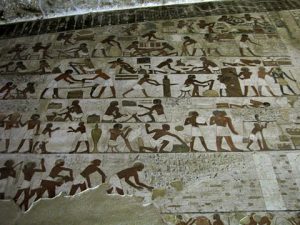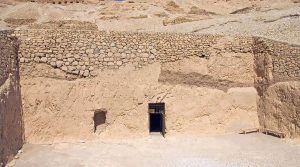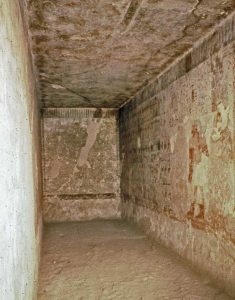
Since he had descended from a noble family of viziers, Rekhmire was helped to rise rapidly in the bureaucracy. He was Vizier of Upper Egypt, Mayor of Thebes, and holder of many other important titles under the reign of Thutmes III and the early years of Amenhotep II. Among other numerous functions, he supervised almost all the activities of governance, the construction of great temples, the irrigation plans, the official ceremonies, and the collection of taxes, amounting to the extent that he said about himself: "there was nothing of which I am ignorant in heaven, on earth, or in any quarter of the underworld." Since the nineteenth century, explorers knew where his tomb was. In 1831, Frederic Caillaud published some of its scenes, but it was not until 1943 that all the scenes were published after the whole tomb had been cleaned in 1889. The scenes in the tomb are divided into two parts, with one (depicted in the transverse hall) manifesting the King's job, titles and duties. In the inner room, we find paintings of daily activities and arts.
- Entrance and Transverse Hall of the Tomb of Rekh-Mi-Ra

Entering the Tomb of Rekhmire, one finds prayers to some of the principal gods of Egypt: Ra-Harakhty, Amun-Ra, Thoth and Osiris, whom he wishes would protect him in the Hereafter. On the right, one finds the important text of Rekh-Mi-Ra describing his titles, jobs and duties as a vizier. Continuing rightwards, we can admire the scenes of tax collectors receiving deliveries of gold rings, cattle, monkeys, grain, honey, pigeons, cloth, and beads. Similar scenes are also depicted on the left (north) side. In the top register, we can count more than thirty different kinds of temple furnishings, including shields, spears, quivers, necklaces, axes, and pots. On the left (south) side of the chamber's rear (west) wall, one can see Rekhmire receives huge quantities of tribute on behalf of the pharaoh from various foreign countries: from Punt, he receives ostrich feathers and eggs, myrrh trees, ivory tusks, gold, leopards, cheetahs, monkeys, and baboons ; from Crete (Keftiu), he receives silver, gold, bronze, and lapis lazuli; from Nubia, he receives ebony, gold, leopard skins, ostrich feathers and eggs, semi-precious stones, and live animals (like hunting dogs, a leopard, a baboon, a giraffe and a monkey); and from Syria, he receives a bear and an elephant. On the right (north) half of the rear (west) wall, men are depicted pressing grapes; gathering birds and fish; as well as cleaning and preserving them in jars. Continuing leftwards, one finds quite interesting hunting scenes.
- The Passage at the Tomb of Rekh-Mi-Ra

The second room of the Tomb of Rekh-Mi-Ra is called the 'Passage'. Scenes on walls on the right side of this room show the activities of Rekh-Mi-Ra as a vizier and depict his funerary rituals. On the left side, there are workshops dedicated to the different works of the Karnak Temple supervised by Rekh-Mi-Ra. These scenes have an extremely high historic value, which lies in that they might have allowed us acquire much more knowledge about the life in Ancient Egypt more than from any other source. One finds seated Rekh-Mi-Ra viewing the provisioning of the storerooms of the Temple of Amun; making pastry of tiger nuts; handling bookkeeping; and providing the many materials for the temple, such as: piles of ostrich feathers, skin shields , elephant tusks, baskets of grapes, sacks of nuts. Besides the formal and serious scenes of the daily work of a vizier, one can also appreciate the sense of humor in the scenes of the monkeys trying to steal fruits. To the right of these activities, men practicing various labors and crafts are gracefully depicted: bead makers, sculptors, jewelers, and workers are depicted preparing sandals, saddles, ropes, and leather for writing documents; carpenters are shown cutting, drilling, sawing, and sanding pieces of wood; and metalworkers are captured fabricating gold, silver and bronze vases and ewers.
The scene that depicts men making bricks for the construction of the Temple of Amen (at Karnak) is a considerable piece of evidence that Ancient Egyptians used ramps in building constructions. It also indicates how huge the Great Hypostyle Hall had been built. Also seen are Syrian and Nubian captives working in the construction of the temple. At last, we can also eye the procession of the burial ceremony of Rekh-Mi-Ra carried into the tomb with food offerings watched over by the Mistress of the West, Anubis and Osiris.

